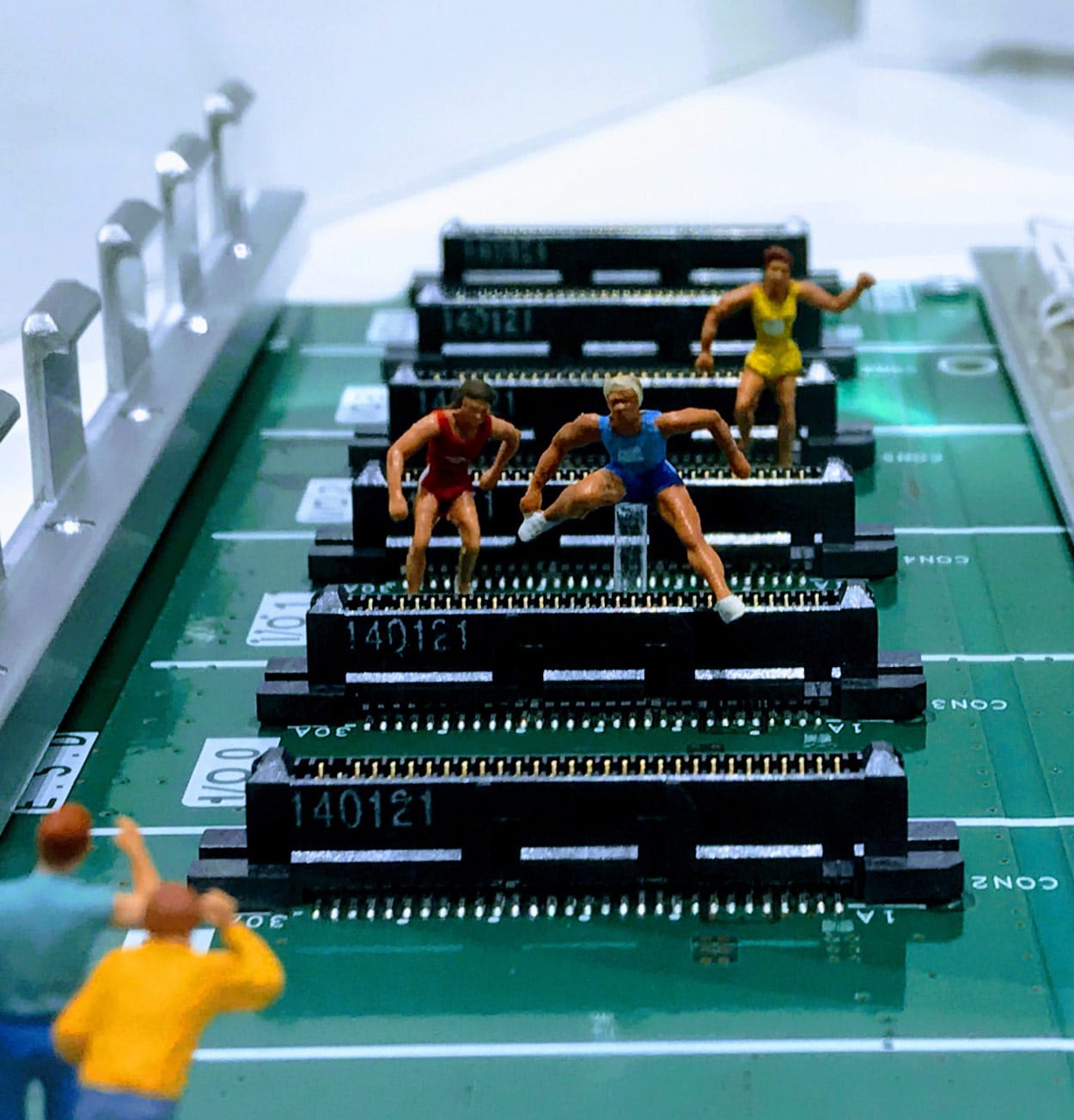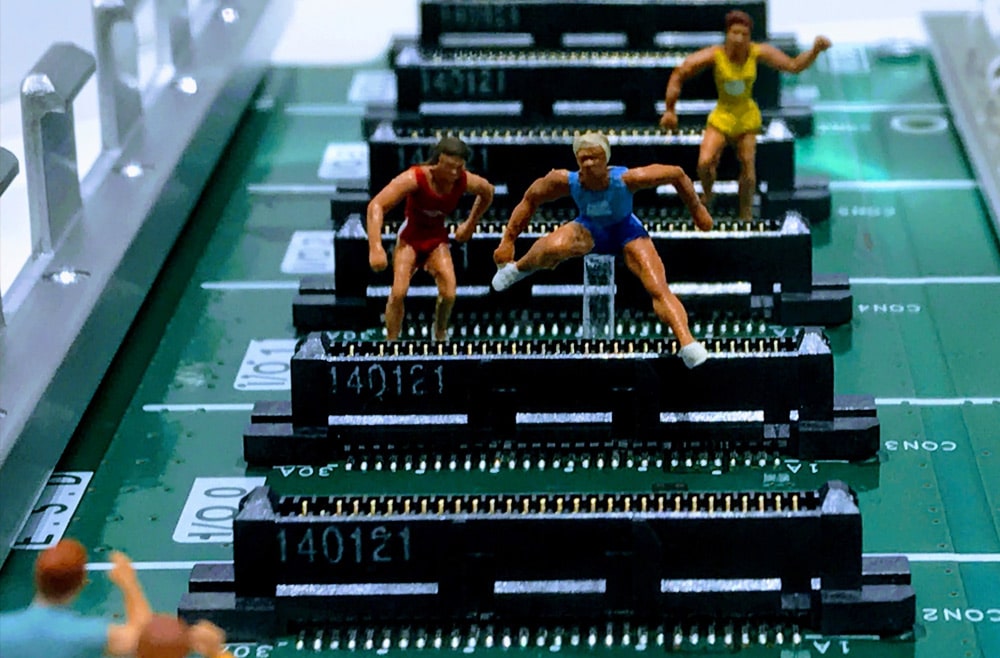Although investment in microgrids and other Distributed Energy Systems (DES) is growing at over 10%-37% CAGR (depending on specific technology, e.g. microgrids, 10.6%; distributed storage, 38%), we still see more pent up demand for DES than we see deals signed and projects completed. Why is that? Energy end users want DES, investors want to put money to work, equipment companies want to sell widgets, and services companies want to deliver projects. What is creating the bottleneck?
In many cases, an optimized microgrid more than pays for itself, in lower utility bills, improved fuel efficiency, and increased reliability and resilience, meaning more uptime and improved safety. However, soft costs in project screening, feasibility, detailed design, engineering, and transaction handling account for about a third (32%) of the Total Installed Cost (TIC) of the average microgrid. These high soft costs and several other market inefficiencies dampen the DES market. This post explores five major points of friction and possible solutions.

#1 – Complexity
Problem: While a handful of companies are focusing on the “product led” or “plug and play / microgrid in a box” approach, applications where a productized DES fits are limited. The large majority of DES today, and the large majority of the most important loads to serve, require custom design for a specific purpose. Due to the complexity of the systems and the number of variables that will change over a project’s useful life, even the most basic screening assessment, such as determining whether a DES will cost less than utility service, is itself time-consuming, expensive, and error-prone.
Lack of a standard, structured approach to screening projects, validating design optimization, and confirming project bankability has the industry comparing apples to pineapples. Each market participant (energy consumers, investors, equipment vendors and services companies) has their own language and approach, and no two projects are identical.
Solution: The market needs coordination and standardized processes for gathering site specific data, modeling the potential systems, and presenting results in intuitive interfaces that make clear sense to each different market participant. This can only be achieved by a community of co-creators who come together and develop these standard processes and interfaces collectively, each bringing insights from their own unique perspective.
#2 – No Single Tool
Problem: If you’ve ever modeled a microgrid or other DES, you know the state of the art. Economic simulation may be done in HOMER; PV output estimated in PVSyst, HelioScope, PVWatts, or similar; BESS sizing assessed with StorageVET; powerflow analysis completed in PSSE, ETAP, Cyme, etc. Each step, each component, a separate tool. Most of us have also built a homemade tool in Excel or MATLAB to bring together the different outputs from the other tools.
With a separate modeling tool for each major component, with technical and financial optimization disconnected from each other, there is no way to model the entire complex system as one whole. Modeling the system as a whole allows each of the component energy assets to vary to achieve the optimal sizing of each, and of the overall system.
Solution: In the world of DES modeling, one software toolkit stands apart from the rest in two important respects. First, while other models often claim to be “optimizers,” they in fact take the approach of simulation (that is, make your best guess as to sizing and run the simulation to see how the system might perform), XENDEE is a true optimizer. XENDEE requires only the known parameters of the load that will be served and searches the entire technically possible solution space to identify the least-cost option. Second, XENDEE optimizes the system as a whole while simultaneously considering all possible technologies for conventional and renewable generation, storage, and controllable loads. All options in one tool, with no guesswork.
#3 – Upfront Cost
Problem: In some cases, an onsite energy system takes the place of putting in an expensive transmission line to a very remote location. But more often, a grid interconnection to the site already exists or is the least-cost option in terms of capital expense. By definition, creating a Distributed Energy System involves installing new, advanced energy technologies, often for a facility that has the option to simply buy power from the grid. How can an onsite energy system be cheaper than the grid?
Solution: Energy as a Service (EaaS) financing can turn a new DES from a capital expense to opex from the perspective of the energy end user. It all starts with optimally sizing the system to ensure adequate supply and necessary redundancy, without overspending on anything needless. Along with optimization, taking the technology neutral approach helps ensure bankability, as no single company offers all of the best components for a DES and to be future-proof includes avoiding vendor lock.
An optimized, technology neutral DES may be an attractive investment for the energy user, but if not, accessing financing through EaaS can be the solution. EaaS can be cheaper than grid power, and in general includes greater value through performance guarantees and dedicated service.
#4 – Lack Of Market Transparency
Problem: Imagine you want a plane ticket. You go to an online platform and see all the offerings that fit your criteria, with accurate, easy to compare, real time pricing. Now imagine you want a microgrid controller. How do you find accurate pricing? How do you compare across different companies’ offerings? The normal approach these days is to send out Requests For Quotations (RFQs) to as many companies as seem to have something you may want. Often, technical consultants are hired for the process, which can take months, cost a lot of money, and at the end of the day you still don’t know if you’ve seen the best pricing on the best the market has to offer.
Solution: Marketplace Platforms have transformed the world, changing how we buy plane tickets, books, lodging, mobility, food delivery, dog walking, and much more. Prices have become transparent and competitive. It’s easy to compare two comparable goods or services, and user ratings ensure good providers see their business increase, while bad providers get dinged with zero-star reviews and lose market share. Platforms have created amazing value in markets for consumer goods and services. The right platform and the right ecosystem of partners can do the same for the mostly business-to-business market of Distributed Energy Systems.
#5 – Future-Proofing
Problem: With technologies changing so fast, is this year the right time to invest in DES? Will I be locked into my choices and lose flexibility later? Will I spend too much? These concerns highlight the need for scenario planning and testing sensitivity to price changes over the full project useful life–prices of both energy technologies, and primary energy sources. On the plus side, DES are modular and components can always be added later, but it’s still critical to know what asset investments to commit to, when.
Solution: In the modeling and design stage, the full project lifecycle (usually 20-25 years) must be considered with all variability built into the model. This should include at minimum variability in energy costs, energy use, ambient temperature, technology costs for all major components, and impacts of unplanned facility use changes caused by economic conditions, natural disasters, and the like. Beyond modeling, in specifying the equipment and software to be installed, project planners should always require open standards for interoperability and serviceability. Finally, with all these factors considered, the model may show, for example, that it is best to add renewable generation this year, and come back to add a Battery Energy Storage System (BESS) in two years’ time, when BESS prices have fallen further.
If the multi-year model shows the financially optimal solution is a staged approach, the model can be saved for re-use later. An automated notice can be set to ping you when prices of key inputs fall to the right range for the project to achieve its hurdle rate for an attractive return on investment (ROI). This flexibility to time the installation of modular components is one of the key value propositions of DES, and when done correctly, DES may indeed be the most future-proof energy technologies the world has yet seen.
Written By Tristan Jackson


